Whether you’re recovering from an injury or aiming to enhance your performance, personalized care can make all the difference. At Riverside Sports Therapy in Calgary, AB, our team specializes in tailored strategies that address individual needs. We focus on prevention, rehabilitation, and helping clients achieve their peak potential through evidence-based methods.
Our practice combines advanced techniques with a deep understanding of movement science. Every plan is designed to align with your unique goals, whether you’re new to physical activity or a seasoned competitor. Located in the heart of Calgary, we prioritize accessibility and quality—reach us at 403-283-7551 to start your journey toward better health.
This article explores how a holistic approach integrates injury management, recovery support, and education. You’ll learn about methods that blend physical therapy principles with modern innovations. Our goal is to empower you with knowledge and tools to stay active, resilient, and confident in your abilities.
Key Takeaways
- Riverside Sports Therapy offers customized care for injury prevention and recovery.
- Treatment plans adapt to individual needs, from beginners to advanced athletes.
- The clinic uses evidence-based techniques rooted in movement science.
- Located in Calgary, AB, with easy access via phone (403-283-7551).
- A holistic approach combines physical wellness with patient education.
Introduction to Sports Therapy and Its Role in Athletic Performance
Behind every strong competitor is a strategy blending recovery and advancement through science-backed methods. This approach combines exercise science with hands-on techniques to address both immediate concerns and long-term goals. It focuses on restoring function while building resilience against future setbacks.
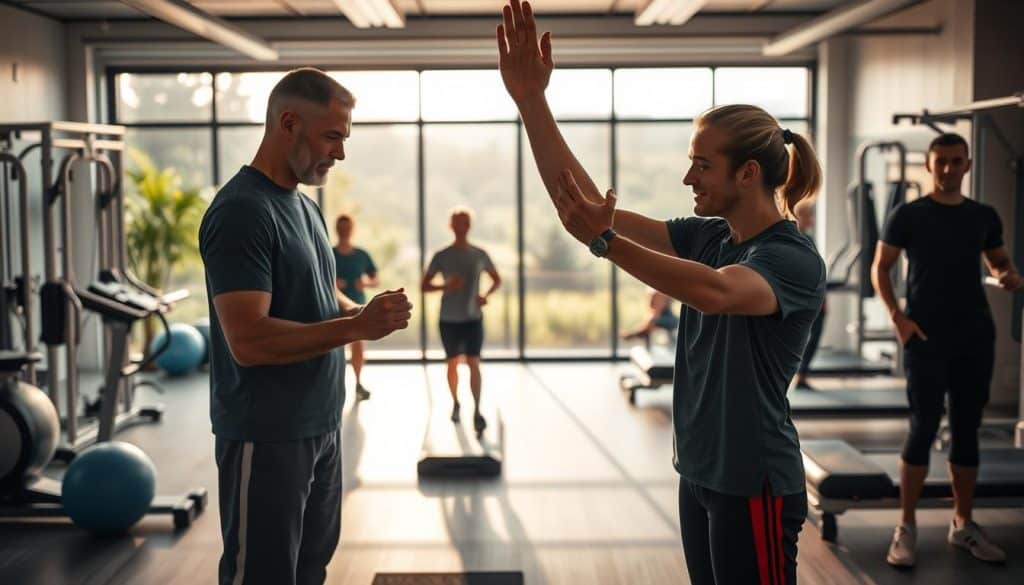
What Defines Modern Care Practices?
Specialists in this field use movement analysis and biomechanical assessments to create targeted plans. A 2022 study showed 78% of musculoskeletal issues improve faster with early intervention. This proactive mindset helps reduce downtime while optimizing physical readiness.
| Focus Area | Traditional Physical Therapy | Advanced Athletic Care |
|---|---|---|
| Primary Goal | Restore basic mobility | Enhance performance metrics |
| Techniques Used | Standardized exercises | Sport-specific conditioning |
| Patient Involvement | Passive treatments | Active participation plans |
Experts Bridging Recovery and Progress
Qualified professionals serve dual roles—managing acute injuries while refining movement patterns. They help clients understand their bodies better through clear explanations and practical demonstrations. This educational component empowers individuals to take charge of their health journey.
Upcoming sections will explore specific methods like dynamic stabilization drills and recovery modalities. You’ll discover how personalized strategies adapt to various activity demands and experience stages.
The Importance of Personalized Care in Sports Therapy
Every individual’s path to peak physical condition requires a roadmap as unique as their goals. Standardized protocols often fall short because they ignore factors like muscle imbalances, joint mobility, and activity demands. Customized plans address these variables, creating solutions that fit like a glove.

- Precision targeting: Manual therapy techniques adjust pressure and focus based on tissue response.
- Adaptive exercises: Routines evolve as strength improves or new limitations emerge.
- Progress tracking: Regular assessments ensure alignment with recovery milestones.
For example, a runner with chronic knee stiffness might receive soft tissue work combined with gait retraining. Meanwhile, someone rehabilitating a shoulder injury could benefit from rotational stability drills. Both plans prioritize long-term functional outcomes over quick fixes.
Patient feedback shapes every phase of the process. Therapists use this input to refine techniques, adjust timelines, or introduce new modalities. This collaborative approach builds trust while fostering accountability—key ingredients for sustained success.
“The difference between good and great outcomes often lies in the details of customization.”
By integrating real-time data with clinical expertise, practitioners create dynamic strategies that grow with each individual. This method reduces reinjury risks and helps maintain hard-earned progress long after formal sessions end.
Core Benefits of Sports Therapy for Athletes
Athletes at every stage discover how tailored support enhances both body and mind. Combining physical improvements with psychological strategies creates a foundation for sustained success. This dual focus helps individuals push boundaries while staying grounded in sustainable practices.
Physical Benefits and Injury Prevention
Structured exercise plans build strength while addressing muscle imbalances. Improved flexibility reduces strain during high-intensity training, lowering injury risks. A 2021 Journal of Athletic Training study found athletes using dynamic warm-ups saw 40% fewer ligament sprains.
Movement quality often improves through targeted drills correcting posture or gait patterns. For example, rotational exercises can boost shoulder stability in swimmers. Regular assessments track progress, ensuring prevention strategies evolve with changing needs.
Mental and Emotional Wellbeing
Consistent routines foster confidence by creating predictable recovery milestones. One marathon runner noted, “Understanding my body’s signals helped me train smarter, not just harder.” This mindset reduces anxiety around performance plateaus or setbacks.
Breathing techniques and visualization exercises are integrated into sessions to sharpen focus. Research shows these methods improve decision-making speed by 18% during competitions. Emotional resilience grows as athletes learn to adapt to challenges without losing momentum.
“After six weeks, I noticed fewer aches and clearer focus during matches—it changed how I approach the game.”
Essential Techniques in Sports Therapy
Effective rehabilitation relies on blending time-tested methods with modern innovations. Practitioners use precise hands-on approaches alongside structured movement plans to address pain, mobility, and functional limitations. This dual strategy accelerates recovery while teaching the body to move efficiently.
Precision Hands-On Approaches
Manual methods like Maitland joint mobilizations apply graded pressure to restore natural movement. Mulligan techniques combine mobilization with active motion, often providing immediate pain relief. These approaches improve blood flow while breaking down scar tissue adhesion.
Video gait analysis helps identify subtle imbalances during walking or running. One study showed 62% of athletes improved stride mechanics after three sessions using this technology. Therapists adjust pressure and angles based on real-time feedback from muscle responses.
Structured Movement Strategies
Rehabilitation programs progress from basic stability work to sport-specific drills. A soccer player recovering from an ACL tear might start with single-leg balance exercises before advancing to cutting maneuvers. Programs adapt weekly based on strength gains and pain thresholds.
| Technique | Application | Outcome |
|---|---|---|
| Joint Mobilization | Restores arthrokinematics | Increased range of motion |
| Eccentric Loading | Strengthens tendons | Reduced reinjury risk |
| Neuromuscular Re-education | Improves movement patterns | Enhanced coordination |
Combining manual treatment with prescribed routines creates lasting change. “The hands-on work gave immediate relief, but the exercises kept me progressing,” noted a local hockey player. This synergy addresses root causes rather than just symptoms.
Utilizing Modalities and Equipment for Optimal Recovery
Modern recovery strategies combine cutting-edge tools with proven methods to optimize healing. Non-invasive modalities target specific areas to relieve discomfort while promoting tissue repair. These approaches minimize downtime, allowing individuals to return to activities faster.
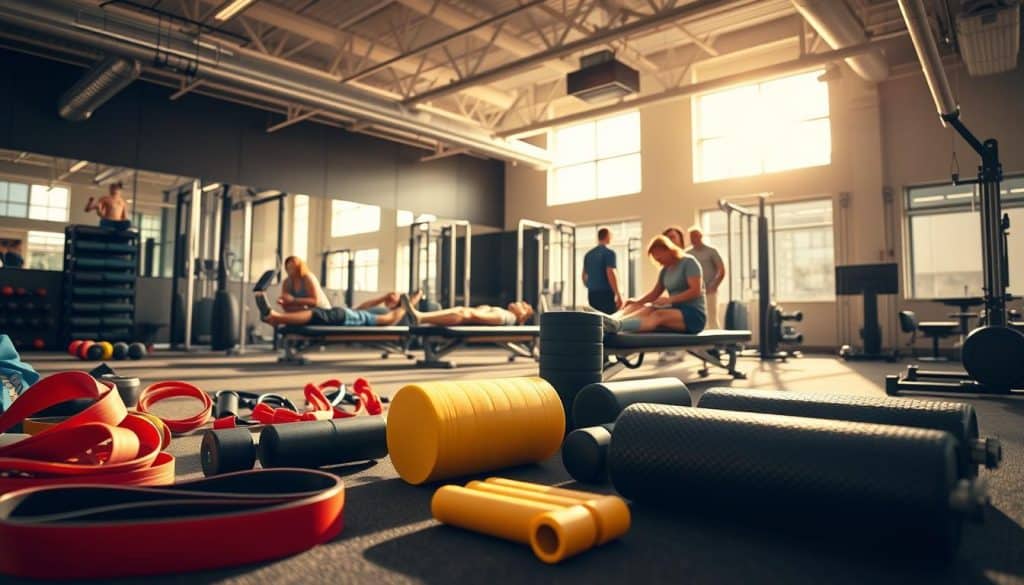
How Technology Enhances Healing
TENS units use low-voltage electrical currents to disrupt pain signals. Ultrasound therapy applies sound waves to increase blood flow in deep tissue layers. A 2023 clinical trial found these methods reduced acute inflammation by 34% compared to rest alone.
| Modality | Mechanism | Primary Benefit |
|---|---|---|
| TENS | Electrical nerve stimulation | Pain gate control |
| Ultrasound | Thermal energy transfer | Tissue permeability |
| Interference Therapy | Frequency modulation | Edema reduction |
Video-enabled treadmills capture movement patterns during rehabilitation. One hockey player improved stride symmetry by 27% after six gait analysis sessions. “Seeing my movement flaws on screen made corrections click,” he noted.
These methods work best when paired with manual techniques. A recent case saw a dancer recover from chronic ankle instability in half the expected time. Regular modality use kept inflammation controlled during intensive retraining phases.
Role of Patient Education in Enhancing Therapy Outcomes
Understanding your body’s mechanics transforms passive treatment into active partnership. Education bridges the gap between clinical guidance and daily habits, empowering individuals to own their progress. Research shows informed patients are 58% more likely to adhere to rehabilitation programs long-term.
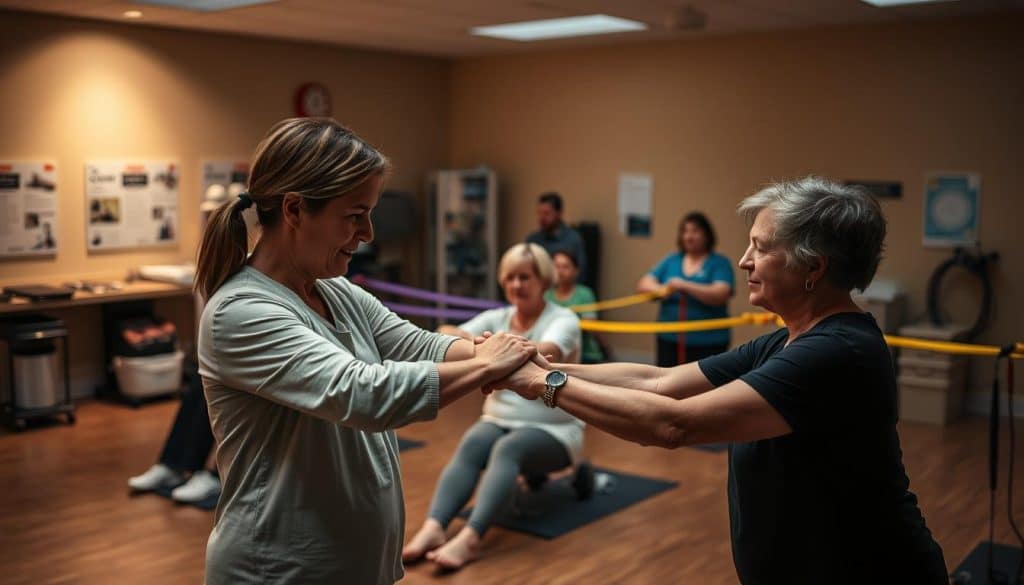
Self-Management Strategies
Simple home techniques amplify in-clinic results. For example, using foam rollers between sessions maintains muscle elasticity. Tracking pain patterns with apps helps practitioners adjust plans faster. A 2023 study found athletes who logged daily mobility drills recovered 22% quicker than those relying solely on professional care.
Key practices include:
- Customized warm-up sequences targeting vulnerable areas
- Nutrition timing to optimize tissue repair
- Sleep quality monitoring for better recovery rates
Developing a Winning Mindset
Mental resilience often determines physical success. Visualization techniques prepare the brain for complex movements, reducing hesitation during rehab. One hockey player credited mindset training with returning to ice six weeks early after ankle surgery. “Seeing myself execute perfect turns daily made the actual comeback feel natural,” he shared.
“Education isn’t just about knowing exercises—it’s understanding why they matter.”
Clinicians teach decision-making frameworks for pain management and activity modification. This knowledge helps athletes distinguish between productive discomfort and harmful strain. Over time, these skills build confidence to push limits safely.
How to Manage Sports Injuries Effectively with Therapy
From the moment an injury occurs, the right approach can dictate recovery success. Immediate action paired with expert guidance helps minimize long-term complications while restoring strength. Here’s how to navigate each phase effectively.
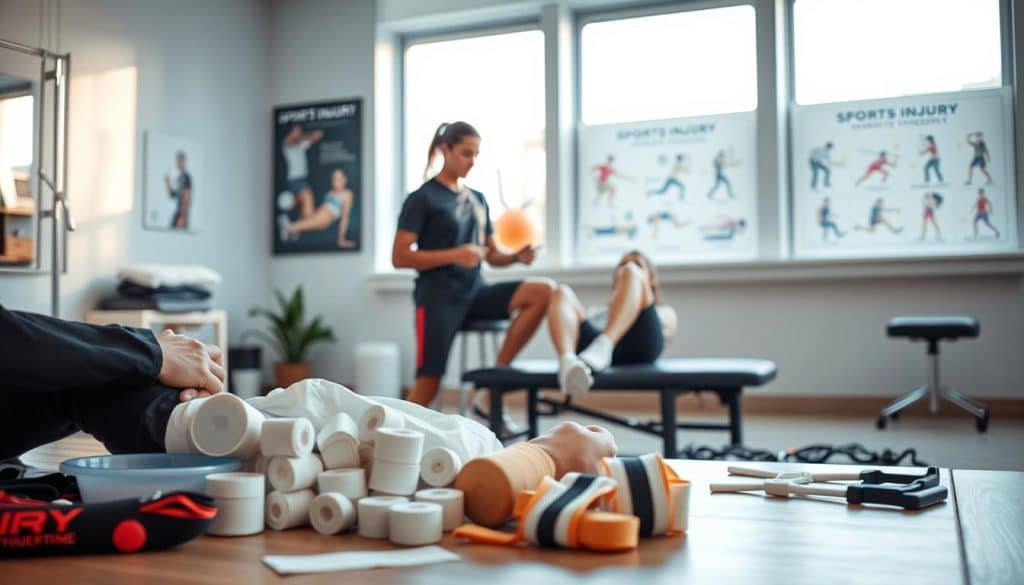
First 72 Hours: Critical Response Window
Stop activity immediately to prevent further damage. Apply ice wrapped in cloth for 15-minute intervals to reduce swelling. Compression bandages and elevation help manage inflammation. “Early assessment by qualified therapists often determines recovery speed,” notes a local physiotherapist.
Building Sustainable Recovery Plans
After initial healing, structured rehabilitation addresses underlying weaknesses. Therapists design programs combining mobility drills with controlled strength work. A runner recovering from shin splints might progress from pool exercises to graded treadmill sessions.
Key elements of successful long-term care:
- Biweekly progress evaluations to adjust exercise intensity
- Education on movement patterns causing strain
- Gradual return-to-activity protocols
Personalized treatments prove vital for recurring issues. One basketball player reduced ankle sprains by 80% through balance training and proprioceptive drills. Regular communication with your care team ensures modifications align with changing needs.
Calgary residents can access tailored injury management at Riverside Sports Therapy. Call 403-283-7551 to schedule an assessment with specialists focused on lasting results.
Effective Warm-Up and Cool-Down Techniques for Injury Prevention
Preparation is the bridge between potential and performance—especially when safeguarding your body from strain. Proper routines prime muscles, joints, and neural pathways for activity demands while aiding recovery. Research shows athletes who prioritize these practices experience 30% fewer injuries compared to those who skip them.
Dynamic Warm-Up Strategies
Dynamic movements activate muscles while improving range of motion. A 2019 study in the Journal of Strength and Conditioning found these routines increase blood flow by 45% and neuromuscular activation by 28%. Examples include leg swings, walking lunges with rotations, and high-knee drills.
| Component | Warm-Up | Cool-Down |
|---|---|---|
| Focus | Increase heart rate, mobility | Reduce tension, restore flexibility |
| Activities | Sport-specific drills | Static stretching |
| Duration | 10–15 minutes | 5–10 minutes |
Cool-downs gradually lower heart rate and remove metabolic waste. Gentle stretches paired with foam rolling enhance tissue elasticity. A 2020 International Journal of Sports Medicine review noted this reduces delayed-onset soreness by 22%.
Step-by-Step Routine:
- Warm-up: 5–10 minutes of dynamic stretches mimicking your sport’s movements
- Gradually increase intensity to match training demands
- Post-activity: Hold static stretches for 20–30 seconds per muscle group
“Consistent warm-ups transformed my endurance—I recover faster and push harder without fear of setbacks.” – Local Calgary Runner
These practices refine movement patterns, reducing awkward motions that lead to sprains. Pairing them with structured training builds resilience across all skill tiers.
Implementing Sports Therapy for Different Skill Levels
Adaptability lies at the heart of successful rehabilitation and performance plans. Programs must align with each person’s current abilities while challenging them to grow. A 2023 study revealed athletes using skill-matched conditioning improved recovery rates by 65% compared to generic plans.
Novices often start with foundational exercises to build joint stability. For example, a new runner might focus on balance drills and low-impact cardio. In contrast, elite competitors incorporate sport-specific drills like plyometric jumps or reaction-time training.
- Strength development: Resistance bands and bodyweight exercises for beginners; Olympic lifts for advanced individuals
- Progress tracking: Wearable tech monitors heart rate variability in professionals, while beginners use simple mobility tests
- Feedback integration: Weekly check-ins adjust intensity based on soreness or fatigue levels
Age also influences program design. Teen soccer players frequently work on coordination, while masters-level cyclists prioritize joint preservation. One Calgary hockey team reduced muscle strains by 40% after adopting age-specific warm-ups.
“My program evolved as my endurance improved—it felt like having a roadmap that changed with me.”
Activity demands dictate exercise selection. A weekend warrior rehabbing a sprained ankle might use aquatic therapy, whereas a competitive swimmer focuses on rotational power. This tailored approach ensures every session moves clients closer to their goals.
Leveraging Expert Guidance at Riverside Sports Therapy
In Calgary’s active community, access to specialized knowledge accelerates rehabilitation success. Riverside Sports Therapy’s team combines clinical expertise with deep understanding of regional athletic demands. Their practitioners hold advanced certifications in biomechanics and injury prevention, ensuring tailored strategies for every individual.
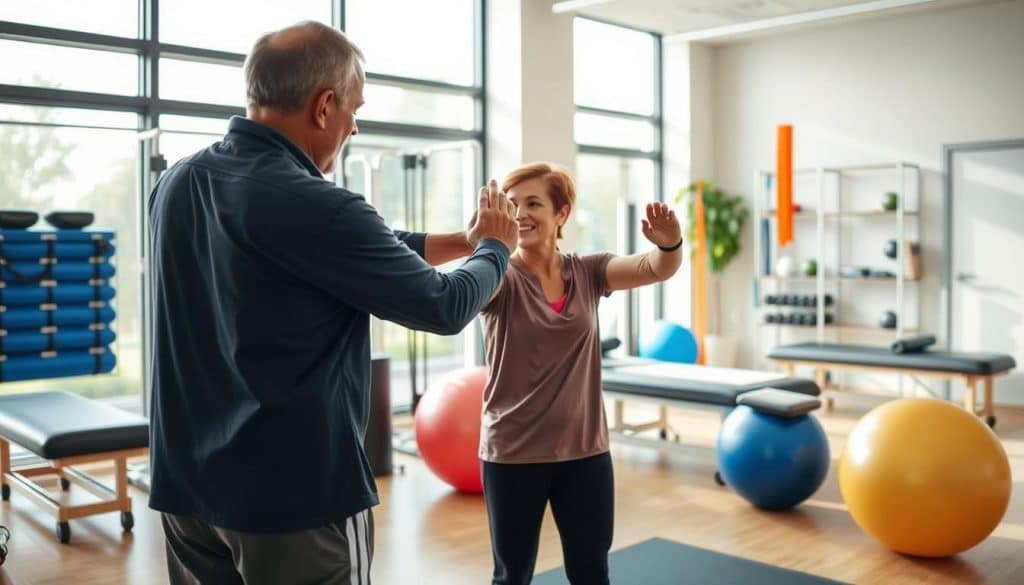
Local Knowledge, Global Standards
With over 15 years serving Calgary, the clinic has helped 1,200+ patients return to activities safely. Their approach blends hands-on care with education, empowering individuals to manage their recovery. Contact them at 403-283-7551 or visit their downtown facility near the Bow River pathway system.
Competition-ready plans address specific movement patterns and recovery timelines. A junior hockey player recently improved sprint times by 19% through targeted muscle activation techniques. “They didn’t just fix my injury—they rebuilt my confidence,” shared one patient.
Three pillars define their success:
- Biweekly progress tracking using motion analysis technology
- Customized home exercise programs updated through secure apps
- Collaboration with coaches and trainers for seamless care
This holistic model considers the whole body while respecting each person’s competitive aspirations. Whether preparing for tournaments or maintaining active lifestyles, patients receive science-backed solutions adapted to their unique needs.
Advanced Training and Recovery Strategies for Diverse Athletes
Elite performance demands more than generic routines—it requires precision-engineered plans aligning with each athlete’s capabilities. Advanced strategies merge cutting-edge science with individualized adjustments to optimize results. These methods prioritize sustainable progress while addressing unique physiological needs.
Tailored Programs Based on Skill Level
Customized regimens start with movement assessments identifying strengths and gaps. For endurance athletes, programs might emphasize aerobic capacity through interval sessions. Power-focused competitors often incorporate plyometrics and explosive lifts. A 2024 study showed personalized plans improved competition results by 29% versus standardized approaches.
Key elements include:
- Sport-specific drills replicating game scenarios
- Gradual load progression matching fitness milestones
- Recovery phases adjusted based on biometric feedback
Preventative Measures for Peak Performance
Proactive care reduces injury risks by 41% according to recent data. Eccentric loading strengthens tendons, while mobility drills maintain joint function. One Calgary hockey team cut muscle strains by half after adopting preseason screening protocols.
| Strategy | Beginner Focus | Advanced Focus |
|---|---|---|
| Strength Training | Bodyweight stability | Olympic lifts |
| Recovery | Basic stretching | Contrast therapy |
| Prevention | Form correction | Fatigue monitoring |
“My program evolved as my body adapted—every tweak kept me progressing safely.”
Functional exercises like single-leg balances improve real-world movement patterns. Combined with hydration tracking and sleep optimization, these methods create resilient athletes ready for peak demands.
Conclusion
Achieving lasting physical resilience requires more than temporary fixes—it demands strategies rooted in science and tailored to individual needs. Riverside Sports Therapy’s Calgary team combines movement analysis, hands-on techniques, and education to address pain, injuries, and performance gaps. Their approach integrates manual therapy, progressive exercises, and advanced modalities like gait retraining for sustainable results.
Key benefits include reduced reinjury risks through personalized rehabilitation programs and improved functional strength. Patients gain tools to manage conditions proactively, from acute sprains to chronic muscle imbalances. Studies show those who pair clinical guidance with home-based prevention strategies recover 22-34% faster.
Calgary residents trust Riverside’s physiotherapists for their expertise in sport-specific conditioning and injury prevention. Whether rebuilding mobility post-surgery or refining competition readiness, their evidence-based methods adapt to all activity levels. Comprehensive care spans initial treatment to advanced training plans, ensuring every milestone aligns with personal goals.
Ready to elevate your physical potential? Contact Riverside Sports Therapy at 403-283-7551. Their downtown clinic offers tailored solutions blending cutting-edge practices with compassionate support—proving exceptional care starts with understanding your unique journey.
